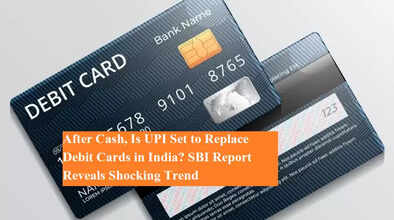After Cash, Is UPI Set to Replace Debit Cards in India? SBI Report Reveals Shocking Trend

India’s payment ecosystem is undergoing a massive digital transformation, and at the heart of this change is the Unified Payments Interface (UPI). Once seen as a convenient alternative for small transfers, UPI has now become the backbone of India’s retail transactions, posing a serious challenge not just to cash but also to debit cards.
According to a recent report by the State Bank of India (SBI), every ₹1 worth of transaction conducted through UPI has reduced debit card usage by ₹0.14. This finding highlights how deeply UPI has penetrated into everyday financial activities, gradually pushing debit cards to the sidelines.
The Rise of UPI: From Niche to Dominance
In 2021, UPI recorded 25.5 billion transactions, already signaling a shift in consumer preferences. By 2023, this number had grown nearly fivefold to 117.6 billion transactions. The momentum didn’t stop there—by 2024, UPI had crossed the 130-billion mark, accounting for more than 75% of all retail digital transactions in India.
From grocery shops and street vendors to e-commerce platforms, UPI has become the go-to payment method. The combination of zero transaction fees, instant transfers, and round-the-clock availability has made it far more attractive than debit cards, which still rely on swipes, PIN entry, and ATM-based withdrawals.
Debit Cards Lose Ground
Debit cards were once considered the most accessible digital payment tool for the average Indian. In 2021, debit card usage stood at ₹83 billion. However, UPI overtook this figure by 2022, marking a turning point in India’s financial landscape.
The report underlines that debit cards are now increasingly limited to cash withdrawals at ATMs, while their role in point-of-sale transactions has been steadily declining. Consumers find it easier to scan a QR code or make a quick transfer via a smartphone app rather than swiping a card and entering a PIN.
Why UPI is Winning
Several factors explain UPI’s rapid dominance:
-
Ease of Access: Almost every bank and fintech app integrates UPI, allowing seamless transactions without additional charges.
-
QR Code Penetration: From large malls to roadside stalls, the near-universal availability of QR codes makes UPI payments simple and fast.
-
24/7 Availability: Unlike card transactions that may face network or banking hour restrictions, UPI runs continuously without downtime.
-
No Extra Cost: UPI transactions remain free for most users, whereas card swipes may sometimes involve merchant fees.
This winning mix has made UPI not only the preferred choice for micro-payments but also for larger transactions, effectively reducing the relevance of debit cards.
Impact on Banking and Retail
Between 2021 and 2025, the report highlights that UPI has redefined retail and banking operations. Banks are witnessing reduced dependency on ATMs and card-based systems, while retailers are adapting to digital-first payment models.
The retail sector, in particular, has benefited from faster checkouts, reduced cash handling, and lower transaction costs. For consumers, the convenience of scanning a QR code instead of carrying a physical card has proven transformative.
What Lies Ahead?
Experts believe that if the current growth continues, debit cards may follow cash in becoming a secondary payment option, used only in specific scenarios such as international travel or ATM withdrawals.
While credit cards still hold a niche appeal due to rewards and EMI options, debit cards appear to be losing their relevance in India’s rapidly digitizing economy. UPI, with its government support and deep integration into everyday commerce, seems well-positioned to lead the future of payments.
Key Takeaway
The SBI report makes one thing clear: UPI is no longer just an alternative—it is the new normal. With its unmatched convenience and growing acceptance, UPI is not only pushing cash aside but is also rewriting the future of debit cards in India’s financial system.

